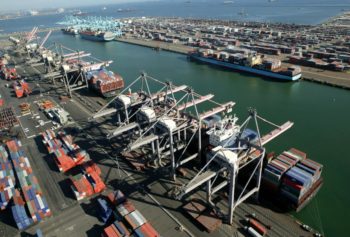
Growing imports at the US major retail container ports set an all-time monthly record this summer, and 2017 is forecast to reach a new yearly record, according to the monthly Global Port Tracker report published by the National Retail Federation (NRF) and Hackett Associates. However, despite the record imports, cargo volume increases are expected to slow down in the coming year.
“2017 is turning out to be a bumper year, causing a sense that growth is unstoppable,” Ben Hackett, Hackett Associates Founder, said.
“Taking this view is risky, however. As we look forward, our models are projecting a slowdown. The positive takeaway is that this is a slowdown in growth, not an actual reduction in volume,” Hackett further said.
West Coast imports are expected to grow only 0.3 percent during the first half of 2018 over the same period in 2017. On the East Coast, which has been gaining market share from the West Coast, volume should grow 1 percent.
After the busy holiday season, January 2018 is forecast at 1.63 million TEU, down 2.6 percent from January 2017.
Ports covered by the report handled 1.78 million TEUs in July, the latest month for which after-the-fact numbers are available. That was up 5 percent from June and 9.2 percent from July 2016. It was the highest monthly volume recorded since NRF began tracking imports in 2000, beating the previous record of 1.73 million TEU in March 2015.
Global Port Tracker had previously forecast that the record would be 1.75 million TEU and would be set in August, but the record came in higher and sooner than expected. August’s actual volume was estimated at 1.71 million TEU, a drop of 0.1 percent from last year but still one of the five highest months on record.
“Consumers are buying more, and retailers are scrambling to import more merchandise to keep up with the demand,” Jonathan Gold, NRF Vice President for Supply Chain and Customs Policy, commented.
“Docks have been busier than ever as ships unload cargo headed for store shelves, and that’s a good sign both for retail sales and the nation’s economy,” Gold added.
September is forecast at 1.67 million TEU, up 4.7 percent from last year, October at 1.7 million TEU, up 2 percent, November at 1.61 million TEU, down 2.3 percent, and December at 1.58 million TEU, up 0.5 percent.
While Hurricane Harvey slowed Gulf Coast cargo and Hurricane Irma is expected to do the same in Florida, neither is expected to significantly impact national totals, according to the report.
Growth has slowed from the first half of the year but 2017 is expected to total 19.7 million TEU, topping last year’s previous record of 18.8 million TEU by 4.8 percent. That compares with 2016’s 3.1 percent increase over 2015. The first half of 2017 totaled 9.7 million TEU, up 7.5 percent from the same period in 2016.
Global Port Tracker, which is produced for NRF by Hackett Associates, covers the US ports of Los Angeles/Long Beach, Oakland, Seattle and Tacoma on the West Coast. Additionally, the report includes ports of New York/New Jersey, Hampton Roads, Charleston, Savannah, Port Everglades and Miami on the East Coast, and Houston on the Gulf Coast.